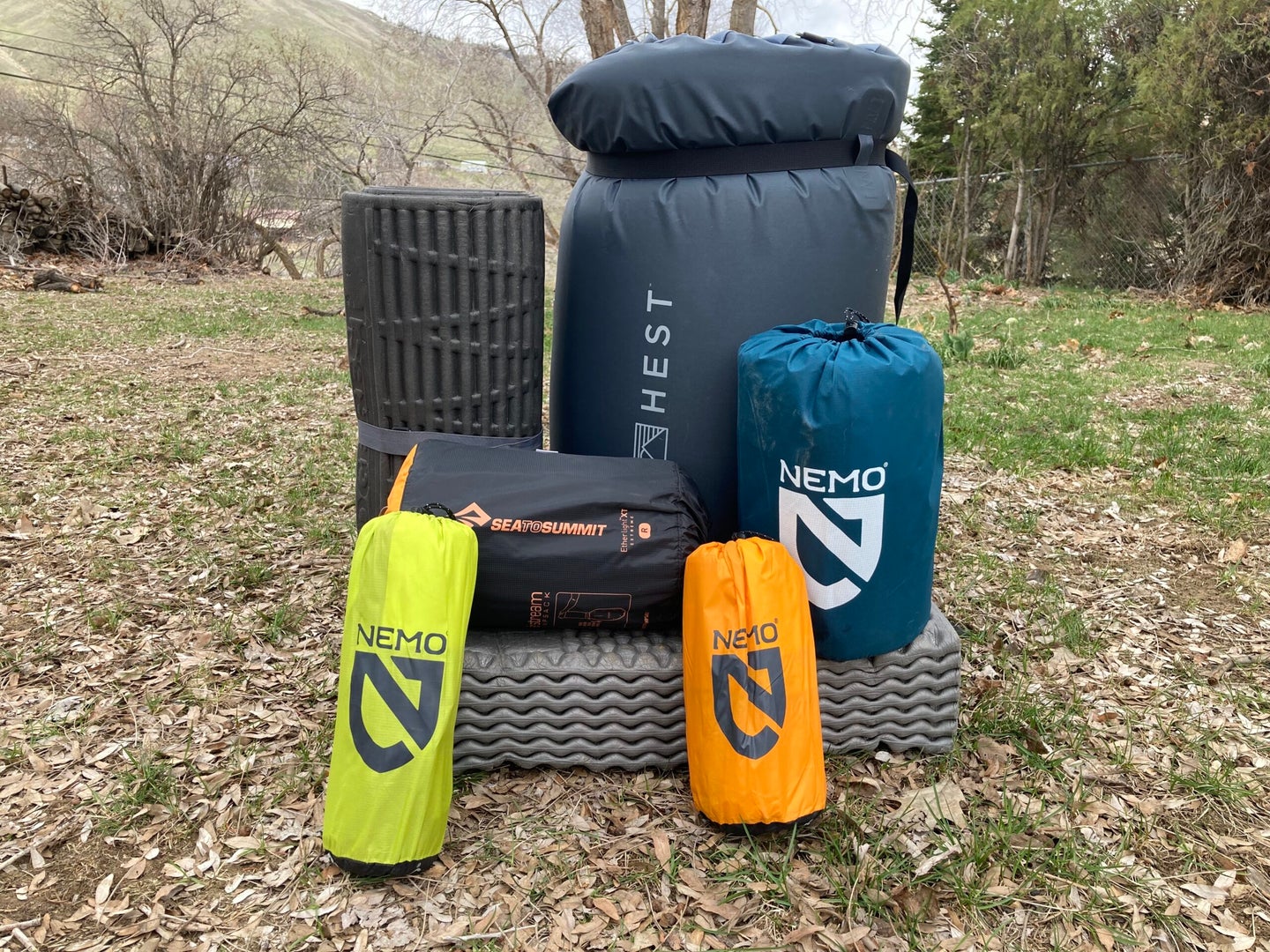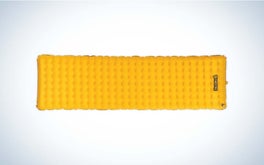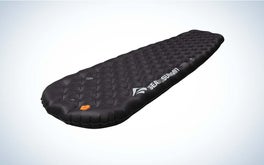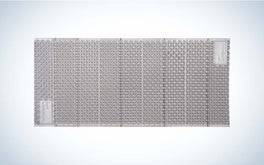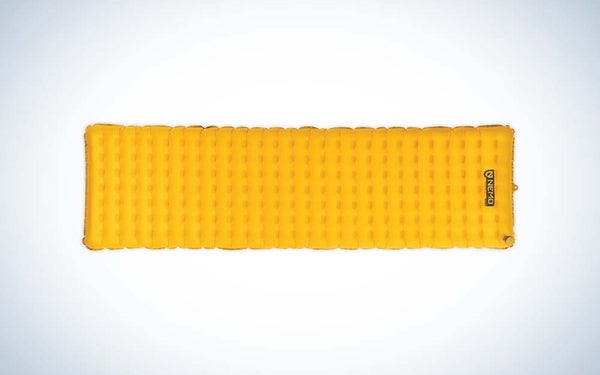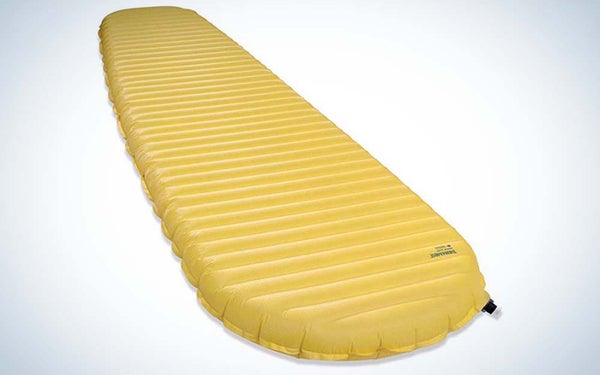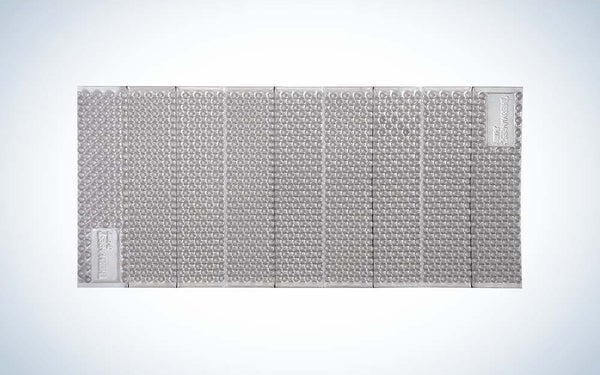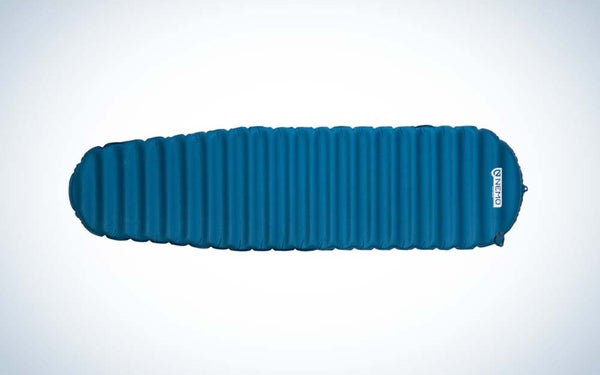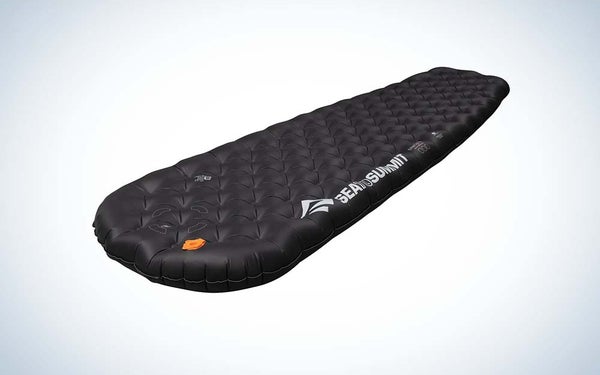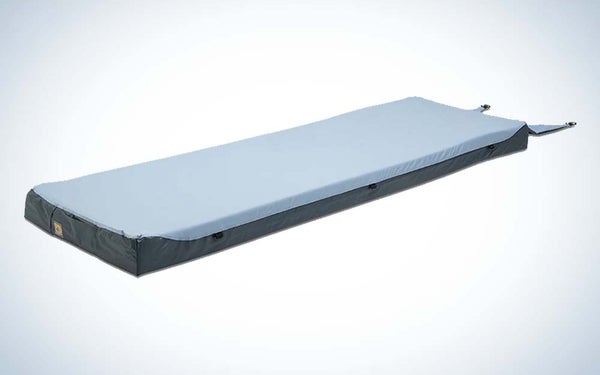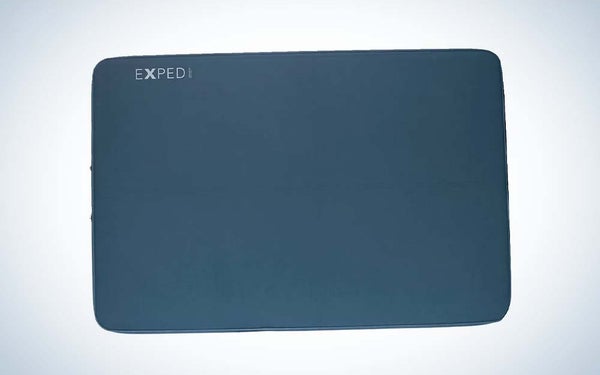We may earn revenue from the products available on this page and participate in affiliate programs. Learn more ›
A quality sleeping pad—no matter the weather or the season—is a necessary part of a camping sleep system. Sleeping pads are designed to insulate your body from the ground to allow for better thermal regulation and overall comfort as you sleep. While a sleeping bag is also necessary for most situations, a sleeping pad is equally important.
The best sleeping pads for camping help keep you warm, add a layer of comfort, and should be portable enough for your intended use. If you’re backpacking, aspects like weight and durability may play a bigger role, and if you are car camping, a larger, more comfortable sleeping pad may be your preference. Since everyone has their ideal sleeping position and camping style, finding the perfect sleeping pad isn’t one-size-fits-all. To help you start your search, we reviewed some of the best sleeping pads for camping for various categories and incomes.
- Best Overall: Nemo Tensor Insulated
- Best for Backpacking: Therm-a-Rest NeoAir XLite
- Best Foam: Therm-a-Rest Z Lite Sol
- Best Self-Inflating: Nemo Flyer Self-Inflating
- Best Insulated: Sea to Summit Ether Light XT Extreme
- Best for Car Camping: Hest Foamy
- Best for Couples: Exped DeepSleep Mat Duo 7.5
How We Picked the Best Sleeping Pads for Camping
Finding and choosing the best sleeping pads is an ever-evolving process. New products come out all the time, but there are always consistent and reliable options that we trust. When looking at our list, you’ll notice a few staple brands that filled multiple categories for good reason. They use quality materials, have ideal warranty and repair policies, and design sleeping pads that fit individual camping needs.
Other factors considered when choosing the best sleeping pads for camping include:
- Warmth: What is the R-value of the sleeping pad? Does it have any specific insulating properties?
- Weight: How much does the pad weigh, and how packable is it? Will this pad work for backpacking and other forms of camping?
- Durability: What is the projected lifespan of the product? Does the company have a warranty and a repair policy? Does the pad come with a repair kit and repair instructions?
- Comfort: Does the pad improve the quality of sleep in the backcountry? How thick is the pad? Is it comfortable for all sleep positions, including sleeping on your side?
Industry-specific knowledge of products and product development, verified customer testimonials, and interviews with brands also influence our choices. Products are subject to change, and descriptions are periodically updated as further information and more detailed product testing is performed.
Best Sleeping Pads for Camping: Reviews and Recommendations
Best Overall: Nemo Tensor Insulated
Specs
- Type of Pad: Inflatable Air
- Materials: 100% PCR PU Polyester, Bluesign Certified
- Thickness: 3 in
- Weight: 15 oz
- R-Value: 4.2
Pros
- Available in several sizes
- Ultralight design
- Pump sack included
- Easy to inflate and deflate
- Packable size
- Nemo Lifetime Warranty
Cons
- Price
- Not the most durable option available
The Nemo Tensor Insulated sleeping pad is an excellent choice for any 3-season backpacker. An ultralight design and packable size make it ideal for trails of any length and difficulty level. Available in both an insulated (R-value 4.2) and non-insulated (R-value 2.5), there is a Tensor design suitable for anyone. While we tested the mummy shape, the Tensor is also available in a rectangle shape. The baffled edges of the sleeping pad help it keep its shape even when you are moving around on the pad for optimal stability. Many other online reviews of this pad may boast the quietness of this pad, but I found the aluminized film to be a little noisy when moving around.
If you are looking for a lightweight sleeping pad that is easy to inflate/deflate, this should be a top contender. It comes with the standard Nemo Vortex pump sack, and it inflates in minutes. When packing the pad away, it deflates quickly and rolls up easily with no difficulty fitting it back into the bag. The only real downside to this bag is that with the ultralight design, we could see it being slightly less durable than some other options on the market. Luckily, Nemo has a lifetime warranty on all of their products, and their pads come stock with a repair kit included.
If you are looking for a good shoulder season or even winter sleep setup, pair the Nemo Tensor Insulated with one of the best cold-weather sleeping bags: the Nemo Sonic.

Best for Backpacking: Therm-a-Rest NeoAir XLite
Specs
- Type of Pad: Inflatable Air
- Materials: 30D rip HT Nylon, Polyurethane
- Thickness: 3 in
- Weight: 16 oz
- R-Value: 4.5
Pros
- Great warmth-to-weight ratio
- Less noisy than previous model
- 4 size options
- New model works for side sleeping
- Additional thickness for more comfort
Cons
- Price
- Edge stability is not as good as other options but seems better than it used to be
It was a near impossible pick between the Therm-a-Rest NeoAir XLite and the Nemo Tensor Insulated sleeping pad. Both of the pads have very similar qualities, R-values, and comfort levels, but the Nemo Tensor won out because of Nemo’s excellent warranty and use of Bluesign fabrics. Regardless, the Therm-a-Rest NeoAir XLite sleeping pad is a pad you can trust for year-round adventures. The older model of this same pad had a few issues (it was so noisy), but Therm-a-Rest seemed to remedy almost everything with this new and improved edition.
Even though this model is about a half-inch thicker than the older one, it isn’t heavier. The additional thickness makes this pad comfortable, no matter the sleeping position (side sleepers rejoice!). The Winglock valve system and included pump sack make for easy inflation and deflation. Plus, this specific valve system allows targeted micro-adjustments to purge some air without getting out of your sleeping bag. As lightweight and packable as this pad is, it is a comfortable and seemingly durable option that provides adequate warmth almost any time of the year.
Best Foam: Therm-a-Rest Z Lite Sol
Specs
- Type of Pad: Molded Closed Cell Foam
- Materials: Crosslinked Polyethylene
- Thickness: 2 cm
- Weight: 14 oz
- R-Value: 2
Pros
- Affordable price
- Lightweight
- ThermaCapture coating
- Durable materials
- Folding design
Cons
- Not the most comfortable
- Bulky to pack compared to inflatable options
The Therm-a-Rest Z Lite Sol is a classic camping pick for both beginners and experts alike. As a closed-cell foam pad, the folding design makes it easier to pack and adapt as a sleeping pad or a sitting pad. Arguably the best part about foam pads like this is that you don’t have to worry about punctures. This pad, in particular, has a very long lifespan, and it may lose some of its cushions over years of use; it can still be utilized as a secondary pad for additional warmth or as a lightweight, portable seat cushion.
One side of the pad is yellow, and the other side has a ThermaCapture surface that appears gray or silver. When the ThermaCapture coating faces up toward your body, it reflects radiant heat to you, and the heat-trapping dimple design amplifies warmth by up to 15%. So, while this pad may only have an R-value of 2, it still has excellent thermoregulation properties. Many campers eventually graduate from using the Therm-a-Rest Z Lite Sol, but it is one of my favorite sleeping pad options and has been for years. It is excellent for warm weather trips and can be used as a backup for additional warmth underneath an inflatable pad during winter camping expeditions.

Best Self-Inflating: Nemo Flyer Self-Inflating
Specs
- Type of Pad: Self-inflating open-cell foam
- Materials: 100% Recycled PU Polyester, Bluesign Approved
- Thickness: 2 in
- Weight: 1 lb 7 oz
- R-Value: 3.3
Pros
- Horizontal coring improves warmth and comfort
- Made from recycled materials
- Nemo Lifetime Warranty
- Rapid self-inflation and easy deflation
- Lighter weight than expected for the pack size
Cons
- Pack size is larger because of the foam
The Nemo Flyer Self-Inflating sleeping pad provides the security and durability of a foam pad with the lightweight and comfort of an air pad. The open-cell foam design utilizes horizontal coring that gives it a higher R-value while using less foam, making it less bulky without compromising warmth or comfort. The horizontal coring is more comfortable than other inflatable pad structures likely because the baffles are linked by solid foam to distribute weight evenly and stop you from bottoming out when the pad is inflated. Inflating and deflating the pad is quick and easy with the dual valve design. The first time inflating the pad took a while for it to self-inflate, but you can speed it up by blowing into the valve as needed. It deflates fairly quickly, but it can be tricky to roll up again because of the foam interior.
It isn’t as thick as other options on the list, but that doesn’t stop this pad from being very comfortable in various sleep positions. As someone that often sleeps on my side or my stomach, I didn’t have any issues. I’m 5-foot-7 and, while the regular pad is just long enough for me, taller people may want to get the long size. Nemo also offers wide versions of both the regular and long pad lengths, which is great for accommodating all body sizes.

Best Insulated: Sea to Summit Ether Light XT Extreme
Specs
- Type of Pad: Inflatable Air
- Materials: 30D/40D nylon
- Thickness: 4 in
- Weight: 1 lb 9 oz
- R-Value: 6.2
Pros
- Thick, comfortable design
- Well-insulated for cold-weather camping
- Adequate comfort for side sleeping
- Pump is integrated into the stuff sack
- Excellent warmth-to-weight ratio
Cons
- Noisy when you move around
- Doesn’t pack down as small as other inflatable pads
If you’re looking for a sleeping pad that keeps you warm even in freezing temperatures, the Sea to Summit Ehter Light XT Extreme is our top pick. The standard Ether Light XT pad is a great all-around pad for shoulder season camping, but for winter or alpine expeditions, you need something with an R-value rated for colder temperatures. Even though this pad has an R-value of 6.2, it is surprisingly lightweight and relatively packable. It won’t be quite as small as other inflatable pad options, but it makes up for that in its high level of warmth and comfort.
The pad is four inches thick, providing additional insulation and an incredibly comfortable sleeping surface. It utilizes dual-layer insulation to prevent internal heat loss within the pad. The pad structure creates a dimpled pattern that further increases heat retention, but sleeping on that pattern is not my favorite, as I prefer the horizontal channel pads. The lamination on the fabric is marketed as quieter, but the pad still makes quite a bit of noise when moving around at night. If you can get past a little bit of noise, this pad offers the highest level of comfort and warmth for cold-weather camping. It is functional in insulation but also offers packability and an efficient inflation system.

Best for Car Camping: Hest Foamy
Specs
- Type of Pad: Memory foam
- Materials: Polyfoam
- Thickness: 3.9″
- Weight: 11 lbs
- R-Value: 8.8
Pros
- Comfortable foam design
- Easy to roll and unroll
- The travel pillow is a nice touch
- Base is made from waterproof materials
- Removable and machine-washable cover
Cons
- Large pack size
- Heavy
Getting a good night’s sleep while car camping or even living out of a vehicle just got a lot easier with the Hest Foamy camping mattress. The largest of all the camping pads we’ve tried, the Hest Foamy is only suitable for motorized adventures. If you choose to use this camping, you’ll be pleasantly surprised by how comfortable this mattress is. Made with two layers of memory foam, this pad is comparable to sleeping on a mattress at home. The waterproof base helps protect the pad from any moisture and allows it to set directly on the ground. Whenever necessary, the pad’s cover comes off and can be tossed into the washing machine for easy cleaning.
Available in regular (11 lbs) and wide (13 lbs) sizes, the Hest camping mattress fits campers as tall as 6 feet. Regardless of the size you choose, the pad is surprisingly easy to transport. Being as bulky as it is, I expected it to be a pain to lug around, but the compression straps and carrying handle keep things contained and manageable. It is evident that the Hest Foam camping mattress is very thoughtfully designed, and for anyone looking for the next level of comfort while camping, it is worth considering. If you’re someone who usually likes to pack an air mattress for your car camping adventures, we can’t recommend this pad enough. The Hest Foamy is not only more durable than a standard air mattress, but it is much warmer and more comfortable as well.


Best for Couples: Exped DeepSleep Mat Duo 7.5
Specs
- Type of Pad: Self-Inflating Air Pad
- Materials: 75D polyester, TPU polyether film laminate, DWR free, [insulation] 16 kg/m² PU foam
- Thickness: 3 in
- Weight: 7 lbs 3.5 oz
- R-Value: 8.5
Pros
- Rated for temps as low as -45°F
- Packs down relatively small for a dual pad
- Durable materials
- Roomy even with two people
- Surface fabric makes it quiet when moving
Cons
- Takes a while to inflate because of the size
Sleeping in a tent with a partner on separate sleeping pads is no fun, so invest in a sleeping pad you can share. The Exped DeepSleep Mat Duo 7.5 is an excellent portable and durable sleeping pad option if you want room to sprawl out solo or if you have pets or are camping as a couple. The large valve and self-inflating design make setting up and deflating a breeze, although it does take the pad a while to inflate because it is rather large. Typical air mattresses make it easy to disturb your partner when tossing and turning as you sleep, but the firm construction and surface fabric cut back on noise.
The high R-value of this pad allows you to use this for year-round camping and makes it feasible to utilize blankets at times instead of always relying on sleeping bags. If you can get past the price of this sleeping pad and camp often with your partner, this pad is worth the investment. Plus, the high comfort level and easy setup make this the perfect replacement for an air mattress when you have guests at home.
What to Consider When Choosing a Sleeping Pad for Camping
Intended Use
Do you plan to go backpacking with your sleeping pad, or are you more into car camping? If you are going backpacking, do you pack ultralight? Is there a sleeping pad most compatible with your current sleeping bag?
These are the types of questions best to ask when shopping for and choosing a sleeping pad for camping. When you know precisely how, where, and how often you intend to use the pad, it is easier to identify the type of pad that best suits your needs.
If you are just starting and aren’t sure what types of camping you’ll like, a versatile pad for both backpacking and car camping is ideal so you aren’t restricted when you decide you may want to branch out. Borrowing or renting gear is also an excellent way to decide the best gear for your camping preferences before you buy gear of your own.
Type
There are three main types of sleeping pads for camping: inflatable air pads, self-inflating pads, and closed-cell foam pads. Other types of foam pads are also popular for car camping setups, like the Hest Foamy pad featured on our list.
- Foam Pads: Closed-cell foam camping mats and other foam camping mats are affordable and durable. They tend to be more functional for backpacking and have better-insulating properties than standard foam mats. While they may be less comfortable than their inflatable counterparts, they’re resistant to punctures. Larger car camping mats may also be made from memory foam materials for more comfort.
- Inflatable Pads: Highly compact and functional, inflatable camping pads can vary in size, thickness, and R-Value. Identifying the insulating properties of the sleeping pad and knowing your comfort level for sleeping outdoors can help you choose the best inflatable pad. The lighter weight and more packable the pad is, the higher the price. While they’re typically easy to set up and highly portable, inflatable pads are the least durable option and are prone to punctures and rips. We recommend carrying a patch kit when camping with an inflatable sleeping pad.
- Self-Inflating Pads: A combination of an inflatable pad and an open-cell foam pad, self-inflating pads inflate simply by opening the upper valve. They pack down larger than inflatable pads but are smaller than standard foam pads. The self-inflating properties make them easy to set up and because they’re partially foam, they offer excellent insulation. Like inflatable pads, self-inflating pads can be punctured or ripped, and we recommend always carrying a field repair kit.
Each type of sleeping pad has its pros and cons. I have been a longstanding fan of closed-cell sleeping pads because of their high level of durability. Plus, they tend to be lighter weight despite being bulkier to carry. However, the firmness and lack of overall comfort on the ground are a big reason many people choose an inflatable pad instead. If you’re a side sleeper, an inflatable or self-inflating pad may be preferable, or if you strictly want to stick to car camping, a memory foam pad may be the most comfortable option.

Ease of Set Up
Foam pads are the easiest to set up, with self-inflating pads behind them. Inflatable pads always require the most labor to set them up, but most brands provide additional tools to help the process.
Most self-inflating pads either have a valve on one corner or a dual valve opening on the top. To inflate them, all you need to do is open the intake valve and let the pad do the work. As the air makes its way into the pad, the open cell foam inflates. You can move the inflation process along faster by blowing into the valve, but it isn’t necessary. The first time you inflate a self-inflating pad, it will take the longest, but after that first time, most pads self-inflate within a matter of minutes.

Inflatable pads may take longer to inflate depending on the mechanism that comes stock with the pad to help you. Now, the standard for many brands is to send a lightweight air sac that attaches to the intake valve. To inflate the bag, attach the inflation sac, blow into the bag, and then roll it down to push the air from the bag into the sleeping pad. It may be effective enough to open the inflation bag and close it again, but others may require some help by blowing air into the bag. Some of these inflation bags are easier to use than others, but they all are relatively effective, allowing you to inflate the pad within a matter of minutes.
Some inflatable pads use a traditional design that requires you to blow directly into the valve. Not only is blowing up a full sleeping pad this way a lot of work, but it can also trap moisture from your breath inside the pad. Over time, that moisture can build up and break down the pad or even cause mold to grow. When choosing an inflatable pad, we recommend looking for one with an inflation option, like a bag or a pump. It saves time and helps improve the overall longevity of the sleeping pad.

Weight and Packability
The type of pad directly affects the weight and packability. Even inflatable pads will vary in weight and size depending on the intended use, materials, and brand. For most backpackers, the small packed size and light weight of inflatable pads make them well worth the extra bit of setup and the lower level of durability compared to foam pads.
The durability may be a question as you get into lighter weight inflatable pads. Fortunately, textiles and sleeping pad design advancements have improved the overall durability of many inflatable sleeping pads. Investing in a sleeping pad from a brand that you trust and that has established field testing of their products is ideal to ensure that the pad is lightweight, packable, and durable enough to withstand the level of use you intend.
Self-inflating pads often have a similar level of durability to that of inflatable pads, but they will not pack down as small and tend to be heavier. The weight of the self-inflating pad is related to the thickness and size, so some are larger than others.
Foam pads are often the lightest weight and most durable, but they are also the bulkiest. Most backpackers that choose a foam pad strap the pad to the outside of their pack because of the size. If you’re a beginner backpacker, foam pads are an excellent choice, but many people eventually age out of those and want something more comfortable. The nice thing about the foam pads is that they last a long time and can work as additional insulation under an inflatable on colder camp nights.
If you are looking for a highly packable and lightweight pad, no matter the type of pad, always look at the R-Value or warmth rating to ensure that it suits your needs. While it isn’t always the case, often, the lighter and smaller the inflatable pad packs down, the lower the insulating properties it has.

Warmth
Sleeping pads add a nice layer of comfort to make sleeping on the ground more bearable, but the primary purpose is insulation. Without a sleeping pad, you lose most of your body heat to the ground. Sleeping pads designed for camping should all have a listed R-value in the product specifications.
The R-value of a sleeping pad measures the level at which the pad resists heat flow through the materials. The higher the pad’s R-value, the better it is at insulating your body from the ground. For most sleeping pads, the R-value ranges from 2-6 but can go higher or lower. Anything with an R-value of six and above is rated for cold weather camping, but if you’re camping in fair weather, then 2-4 is sufficient.
If you decide to stack a foam pad under an inflatable pad to make up for low R-values, to calculate the total insinuating properties, add both pad values together. Utilizing other insulating equipment like a sleeping bag liner is also an option when modifying a gear setup for changing seasons.

FAQ
Q: Do I really need a sleeping pad for camping?
Yes, sleeping pads not only add a level of comfort when sleeping on the ground, but the primary purpose of a sleeping pad is to insulate. Without a sleeping pad, you’ll sleep directly on the ground without thermal insulation.
Q: How thick should a sleeping pad be?
How thick a sleeping pad is depends on the type of sleeping pad and the insulation or comfort level you seek. Most inflatable sleeping pads for camping are anywhere from 2-3 inches thick, whereas foam pads are much thinner, providing less cushion but still insulating quite well.
Q: How do I choose a sleeping pad?
First, identify the intended use and your comfort and sleeping style preferences. Then, knowing which sleeping pad type works best for you is easier to narrow it down. Product specifications such as the r-value, weight, and size of the pad may also influence which sleeping pad you choose. For more detailed information about choosing the best camping sleeping pad, consult the buying guide above.
Q: Do sleeping pads keep you warm?
Yes, sleeping pads insulate your body from the ground and play a massive role in how warm you are while camping. A sleeping pad’s ability to prevent heat loss from your body is measured in an R-Value. When looking at sleeping pad specs, the higher the R-Value, the better heat retention and the more effective it will be in colder conditions. Using multiple pads or insulated sleeping pads is also a good option for cold-weather camping.
Q: How do I use a sleeping pad?
To use a sleeping pad, follow the setup instructions provided by the manufacturer. Some sleeping pads are inflatable, others are self-inflating, and the easiest to use are foam pads. Once inflated (if necessary), lay the sleeping pad on the tent floor area you intend to sleep. Put your sleeping bag atop the sleeping pad, and your sleep setup is complete. Feel free to add a sleeping bag line or a pillow for additional warmth and comfort.
Q: Is a sleeping pad the same as an air mattress?
The main differences between a sleeping pad and an air mattress are the size or level of insulation and the insulation properties. Sleeping pads designed for camping and outdoor use generally provide a higher level of insulation and are more portable than traditional inflatable air mattresses. Since they are intended for outdoor use, sleeping pads also tend to be more durable.
Final Thoughts on the Best Sleeping Pads for Camping
- Best Overall: Nemo Tensor Insulated
- Best for Backpacking: Therm-a-Rest NeoAir XLite
- Best Foam: Therm-a-Rest Z Lite Sol
- Best Self-Inflating: Nemo Flyer Self-Inflating
- Best Insulated: Sea to Summit Ether Light XT Extreme
- Best for Car Camping: Hest Foamy
- Best for Couples: Exped DeepSleep Mat Duo 7.5
The best sleeping pads for camping are durable and easy to set up but above all, they help keep you warm while you sleep. From foam pads to inflatable options, there is a sleeping pad out there that best fits your outdoor adventure needs. While we only included eight of our top options, there are many others to choose from on the market. Brands like Therm-a-Rest, Nemo, and Sea to Summit are consistently our top picks for sleeping pads, and we think they’re a great place to start looking. Even if you didn’t find the perfect sleeping pad for your outdoor needs, we hope our buying guide can help you narrow down your options.
Why Trust Us
For more than 125 years, Field & Stream has been providing readers with honest and authentic coverage of outdoor gear. Our writers and editors eat, sleep, and breathe the outdoors, and that passion comes through in our product reviews. You can count on F&S to keep you up to date on the best new gear. And when we write about a product—whether it’s a bass lure or a backpack—we cover the good and the bad, so you know exactly what to expect before you decide to make a purchase
